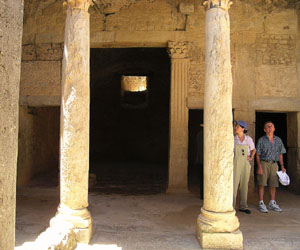Ancient sites in Tunisia, Rome inspire ‘Death, Burial and the Gods’ conference
By Jennifer CarnigNews Office
 Tanya Luhrmann, the Max Palevsky Professor in Human Development and the College, and Richard Saller, Provost and the Edward L. Ryerson Distinguished Service Professor in History, tour the underground villas of Bulla Regia in Tunisia. | |
A conference on Jewish, Roman and early Christian burial practices that took University faculty to Rome and Tunisia will now bring Rome and Tunisia to the University.
“Death, Burial and the Gods: The Shohet Conference on Roman, Jewish and Christian Burials”—scheduled for Sunday, May 22 to Tuesday, May 24, at the Divinity School’s Martin Marty Center for the Advanced Study of Religion—will bring together classicists, historians, scholars of the New Testament, early Christianity and Judaism, art historians, and graduate students from across disciplines to share insights and conclusions about the distinctions and similarities among pagan, Christian and Jewish burials.
To set up the conversation, an interdisciplinary group of 11 professors first had to visit dozens of catacombs, necropolises and burial sites halfway around the world. Last June, the group of colleagues spent a week in Rome and a week in Tunisia, visiting sites such as Isola Sacra outside of Rome and the underground villas of Bulla Regia in Tunisia by day, and presenting research and ideas to each other by night.
The goal of the trip and the upcoming conference was to generate more intentional and in-depth interdisciplinary conversations on Roman history, early Christianity and Judaism, said conference organizer Laurie Brink, a doctoral candidate in the Divinity School who teaches biblical studies at the Catholic Theological Union.
“I wanted to bring together a cross-section of scholars and just get them talking to each other,” Brink said. “We’re all looking at the same period of time, but we’re not involved with each other as much as we could be. Burials create a common ground for discussion.”
Brink received the Shohet fellowship from the International Catacomb Society in Boston in order to fund the project. She then organized a group of top scholars whose work centers on that time period. Among the participants are Richard Saller, Provost and the Edward L. Ryerson Distinguished Service Professor in History and the College, and Margaret Mitchell, Associate Professor of New Testament and Early Christian Literature in the Divinity School. They were joined by faculty from Texas Christian University, Brown University, the University of Oregon, Vanderbilt University, Randolph-Macon College and the British School at Rome.
“Burial practices say so much about how ancient people understood themselves—if they believed in an afterlife, how they viewed their families, what their religious sensibilities were,” Brink explained. “It is an issue that is at stake for all of us, regardless of our discipline. How ancient people viewed the dead says much about how they viewed the living.”
Burial inscriptions are one of the most valuable sources of information—demographic, social, religious, iconographic, historical—from the ancient world, said Mitchell.
 John Bodel, professor of classics and history at Brown University, discusses with Richard Saller (far left) and Tanya Luhrmann (seated at Saller’s right) the monumental Roman remains at Sbeitla in Tunisia. Margaret Mitchell, Associate Professor in the Divinity School (far right), takes notes as Bodel describes the site. | |
“The relationship between text and artifact is marvelously explored through viewing burial inscriptions,” she said. “What was especially valuable about this kind of trip was the experiential component of having a set of participants who include classicists and scholars of ancient Christianity and Judaism traveling together and discussing what they were seeing on an ongoing basis. What was terrific was the way in which the particular areas of expertise within the group clicked in at various points, so the viewing for all was thereby enhanced.”
At the conference, Mitchell will present a talk titled “The Abercius Inscription: Reimagining Context and Meaning.” The epitaph of Abercius of Hieropolis in Asia Minor (Turkey) is often referred to as the earliest Christian inscription, Mitchell said. The funerary monument from the late-second or early-third century tells of Abercius’ trip to Rome and what he saw there. Fragments of it serendipitously ended up back in Rome at the Vatican Museum.
“My own study will show how my own visual imagination was furnished by many things I in turn saw on my trip to Rome, which have helped me to reconfigure what the actual monument may have looked like, and to see the words of the inscription as part of a larger visual program,” she said.
Mitchell’s conference respondents will be two graduate students—neither of whom are New Testament scholars.
“The overall idea for the conference was to create an interdisciplinary conversation for the next generation,” Brink said. “I want my peers to have the opportunity to participate. The most important part is to have the conversation continue, for the next generation to keep speaking with one another.”
Other topics to be presented include “Housing the Roman Dead,” “From Columbarium to Catacomb: Communities of the Dead in Pagan and Christian Rome,” “The Patronage of Women in Roman and Christian Burial Practices,” and “Sweet Spices in the Tomb: An Initial Study on the Use of Perfume in Jewish Burials.” All of the papers will be collected and published in a book within the next year, Brink said.
“The bringing together of all of these different scholars in different disciplines is not unprecedented, but it is not common,” said Saller, who will present the conference’s introductory remarks.
“My hope is that graduate students will see that there is value in working with more than one discipline. We all learned so much from each other. I hope they will seek that exposure as well.” All conference events are open to the public and free of charge. For more information, visit http://marty-center.uchicago.edu. To register, e-mail afrenz@uchicago.edu.
![[Chronicle]](/images/sidebar_header_oct06.gif)